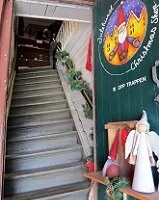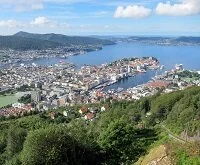In 1940 the Germans took over the city and the entire country of Norway; they occupied the city until the end of the war. During their occupation there were blockades of the city as well as bombings by the Allies, which destroyed pieces of the city, although it was never fully destroyed. This led to numerous architectural renovations after the war.
Since this time Bergen has continued to again grow in power and wealth as they re-gained their status as a major trading and shipping center. The discovery of oil off of Norway's coast has also improved trade and industry in the city. In more recently years the city also benefits from the tourism industry as many people begin their trip to the fjords from Bergen, the self-proclaimed gateway to the fjords.
Bergen Today

Shop in Bergen's
Bryggen
Today Bergen is a vibrant city with an excitement and energy that complement the historic architecture and past. The city is truly a destination as numerous Norwegians make their way to the city to attend university or find jobs and numerous tourists travel here to see the history and to act as a jumping off point to the many nearby fjords.
The city also holds an important place in the hearts and culture of the people as the Hanseatic League city status made it home to outside cultures and influences. This made it one of the most progressive cities in Norway then and today. Even today the city continues to influence Europe and the rest of the world in the form of its atmosphere and as the gateway to the fjords, which are world famous.
Attractions
Natural Wonders
 Floibanen Funicular & Floien Mountain (Fløibanen & Fløyen): This funicular takes you to the top of Floien Mountain, providing excellent views of the city and landscape. For more information visit their website at: www.floibanen.com.
Floibanen Funicular & Floien Mountain (Fløibanen & Fløyen): This funicular takes you to the top of Floien Mountain, providing excellent views of the city and landscape. For more information visit their website at: www.floibanen.com.
Historical & Architectural Sights

View from Fløyen Mountain
 Damsgard Manor (Damsgård Hovedgård): Part of the Bergen City Museum, this manor house was built in the 1700s and is an excellent example of rococo architecture, one of the few good examples of the style in Norway. For more information visit their website at: www.bymuseet.no.
Damsgard Manor (Damsgård Hovedgård): Part of the Bergen City Museum, this manor house was built in the 1700s and is an excellent example of rococo architecture, one of the few good examples of the style in Norway. For more information visit their website at: www.bymuseet.no.
 Rosenkrantz Tower (Rosenkrantztårnet): Part of the Bergen City Museum, this tower from the 1270s has been expanded and re-built numerous times, but was used in the past as a part of fortifications. For more information visit their website at: www.bymuseet.no.
Rosenkrantz Tower (Rosenkrantztårnet): Part of the Bergen City Museum, this tower from the 1270s has been expanded and re-built numerous times, but was used in the past as a part of fortifications. For more information visit their website at: www.bymuseet.no.
 Royal Residence/ Haakon's Hall (Håkonshallen): Part of the Bergen City Museum, this complex, built from 1247-1261, was the home of the Norwegian royalty, which stood in contrast (and at times conflict) with the Hanseatic city of Bryggen. For more information visit their website at: www.bymuseet.no.
Royal Residence/ Haakon's Hall (Håkonshallen): Part of the Bergen City Museum, this complex, built from 1247-1261, was the home of the Norwegian royalty, which stood in contrast (and at times conflict) with the Hanseatic city of Bryggen. For more information visit their website at: www.bymuseet.no.
 St. Mary's Church (Mariakirken): This is Bergen's oldest building (built in the 1100s) and is definitely worth a stop.
St. Mary's Church (Mariakirken): This is Bergen's oldest building (built in the 1100s) and is definitely worth a stop.
Museums, Arts, & Entertainment
 Bergen Aquarium (Akvariet i Bergen): In the aquarium you can meet many of the local animals up close, but it's also home to penguins, turtles, and other sea life. For more information visit their website at: www.akvariet.no.
Bergen Aquarium (Akvariet i Bergen): In the aquarium you can meet many of the local animals up close, but it's also home to penguins, turtles, and other sea life. For more information visit their website at: www.akvariet.no.
 Bergen Art Museum: Part of the Art Museums of Bergen (Kunstmuseene i Bergen), this museum is best known for a collection of Edvard Munch's paintings. For more information visit their website at: www.kunstmuseene.no.
Bergen Art Museum: Part of the Art Museums of Bergen (Kunstmuseene i Bergen), this museum is best known for a collection of Edvard Munch's paintings. For more information visit their website at: www.kunstmuseene.no.
 Bergen Science Centre (VilVite): This museum is great for kids as it makes science and learning fun as you can do games that feel like you're the captain of a ship among other hands-on activities. For more information visit their website at: www.vilvite.no.
Bergen Science Centre (VilVite): This museum is great for kids as it makes science and learning fun as you can do games that feel like you're the captain of a ship among other hands-on activities. For more information visit their website at: www.vilvite.no.
 Bryggens Museum: Part of the Bergen City Museum, this museum is in the heart of Bryggens and explores the life and history of this district, including seeing many of the buildings otherwise inaccessible. For more information visit their website at: www.bymuseet.no.
Bryggens Museum: Part of the Bergen City Museum, this museum is in the heart of Bryggens and explores the life and history of this district, including seeing many of the buildings otherwise inaccessible. For more information visit their website at: www.bymuseet.no.
 Hanseatic Museum & Schotstuene (Det Hanseatiske Museum og Schøtstuene): This museum and the assembly rooms are an inside view of life as a merchant under the Hanseatic League, including the past culture, trade, and items used for daily life. For more information visit their website at: www.museumvest.no.
Hanseatic Museum & Schotstuene (Det Hanseatiske Museum og Schøtstuene): This museum and the assembly rooms are an inside view of life as a merchant under the Hanseatic League, including the past culture, trade, and items used for daily life. For more information visit their website at: www.museumvest.no.
 Old Bergen Museum (Gamle Bergen Museene): Part of the Bergen City Museum, this is an open air museum consisting of numerous wood houses from the 1700s and 1800s. For more information visit their website at: www.bymuseet.no.
Old Bergen Museum (Gamle Bergen Museene): Part of the Bergen City Museum, this is an open air museum consisting of numerous wood houses from the 1700s and 1800s. For more information visit their website at: www.bymuseet.no.
 Theta Museum (Theta Museet): This museum displays Norway's resistance efforts against Nazi Germany during World War II.
Theta Museum (Theta Museet): This museum displays Norway's resistance efforts against Nazi Germany during World War II.
Cultural Activities
 Fish Market (Fiskebrygga): The fish market is probably the best place to see the local culture and daily life in action. The market is filled with restaurateurs creating the evening's menu as well as locals. While here, be sure to wonder through the district known as smau, which consists of small passageways that seem to transport you back in time.
Fish Market (Fiskebrygga): The fish market is probably the best place to see the local culture and daily life in action. The market is filled with restaurateurs creating the evening's menu as well as locals. While here, be sure to wonder through the district known as smau, which consists of small passageways that seem to transport you back in time.
Areas & Neighborhoods of Interest
 Bryggen is the famous Hanseatic city's wharf, which provides some of the best architecture in the country as wood buildings line the water. This was the heart of the historic city of Bergen and it maintains its medieval look today, although many of the buildings are more recent re-constructions. Many of the above mentioned sights are located in Bryggen.
Bryggen is the famous Hanseatic city's wharf, which provides some of the best architecture in the country as wood buildings line the water. This was the heart of the historic city of Bergen and it maintains its medieval look today, although many of the buildings are more recent re-constructions. Many of the above mentioned sights are located in Bryggen.
Official Websites
City of Bergen: www.visitbergen.com
Kingdom of Norway: www.visitnorway.com
Transportation
Bergen is very well connected domestically. The city has a large airport (for Norway) as well as a train station and numerous bus routes. Most major cities in Norway can be accessed by air and most of southern Norway is also accessible by train, including the capital of Oslo. Bus routes are the most extensive means of transportation from Bergen as buses can reach most destinations that train and air don't have access to. Boat is also a great means of transportation from Bergen, especially en route to the nearby fjords.
International transportation to Bergen is more limited, but still fairly extensive. The airport services many regional European routes and has flights to over 50 countries, but many of these only fly limited days each week during the summer months. More regular routes include regional European hubs such as London, Copenhagen, Amsterdam, Stockholm, Berlin, etc. There are also a number of international transportation options via boat, most particularly from Denmark.
 Airport: Bergen's airport is the Flesland Airport located about 11 miles (18 kilometers) from the city's center. The airport code is BGO and the airport's website is: www.avinor.no. For its location or directions, see the map below.
Airport: Bergen's airport is the Flesland Airport located about 11 miles (18 kilometers) from the city's center. The airport code is BGO and the airport's website is: www.avinor.no. For its location or directions, see the map below.
 Train Station: Bergen's main train station is located on the eastern side of town, but centrally located. For train times and schedules, the website is: www.nsb.no. For its location or directions, see the map below.
Train Station: Bergen's main train station is located on the eastern side of town, but centrally located. For train times and schedules, the website is: www.nsb.no. For its location or directions, see the map below.
 Bus Station: There are numerous private bus companies that service Bergen. There are also a couple bus stations and stops, but the main bus station is located close to the train stations and most long-haul bus routes begin or end here. For its location or directions, see the map below.
Bus Station: There are numerous private bus companies that service Bergen. There are also a couple bus stations and stops, but the main bus station is located close to the train stations and most long-haul bus routes begin or end here. For its location or directions, see the map below.
Local Transportation: Public transportation within the city of Bergen is provided by skyss. For more information, visit their website at: www.skyss.no.
Map & Directions